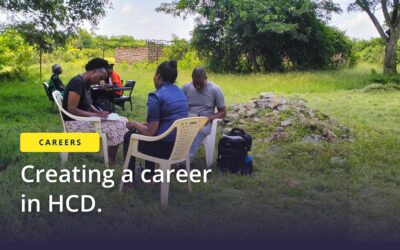The HCDExchange facilitated a webinar with the USAID Advancing Nutrition (UAN) on Wednesday, October 25, 2023 that featured contributions from Riley Auer, SBC Project Officer (JSI/USAID Advancing Nutrition), Jacqueline Oliveira, Executive Designer (ThinkPlace), Angela Samba, Senior MNCH+N Advisor (Breakthrough ACTION), Rowena Merritt, SBC Specialist – Nutrition (UNICEF), and Munyaradzi Chinguwa, Senior HCD Designer (HCDExchange). This interactive webinar offered practical insights and invaluable lessons on integrating Human-Centered Design (HCD) approaches into Social and Behavior Change (SBC) programming.
Lessons from UAN’s participatory implementation research on quality care groups in Zimbabwe and Malawi
UAN used two different but complementary participatory research and design approaches – the HCD double-diamond in Zimbabwe and Living Labs Adaptive Research Methodology in Malawi – to understand participants’ perceptions and challenges to quality care groups and co-create feasible solutions to those challenges.
Learnings from integrating HCD into SBC and implementation research
- It was important to have transparent and consistent communication with implementing partners and research teams. The implementing partners’ connections with the community made the research possible.
- Challenges with respect to translating HCD terminology and remaining flexible to the nuances of the approach emerged when trying to blend design approaches with the research approaches that are more commonly applied to public health programs.
- Throughout the research process, the research team was thinking of quality in terms of five domains that surfaced during the formative exercise which helped them to outline focused design questions: structure, membership, facilitation, focus for behavior change, and community linkages
- Use of participatory approaches enabled research teams to bring together a diverse group of stakeholders for the entire process – they became the co-designers of the solutions and are now advocates for those solutions.
- Care group participants in Zimbabwe co-designed four solutions and group participants and community stakeholders in Malawi co-designed three solutions listed in the graphic below:

“This work demonstrated that participatory research and design processes have the potential to make important shifts in decision-making and local ownership of solutions emphasizing that community stakeholders are critical program resources, as opposed to program beneficiaries.” – Riley Auer, SBC Project Officer (JSI/USAID Advancing Nutrition).
Nourishing Connections at Breakthrough ACTION Nigeria
In Nigeria, counseling on complementary feeding is not tailored to the caregiver’s unique environment and needs, and has been challenging for community health workers (CHWs). CHWs typically only guide caregivers based on generic recommendations and do not foster an environment where caregivers can voice their needs, ask questions, or solve their challenges. As a result, there is a lack of trust between CHWs and caregivers.
Building on this background, Breakthrough ACTION Nigeria used the HCD process to design the Nourishing Connections job aid. This tool supports CHWs and caregivers to engage, create, reflect, and learn from each other. The main tool has four activities:
- Empathways – to encourage compassionate care, remind active listening and sharing of own experiences
- Accessing caregivers’ knowledge – a set of questions that helps CHWs understand practices, challenges, and knowledge of caregivers
- Counseling flow – to co-create actions to be taken to address the caregiver’s unique needs
- Action plan – clear guidance and documentation of recommendations for follow-up
The tool not only facilitates bi-directional interaction that aims to promote connection and compassionate counseling, it also provides an opportunity for knowledge and experience sharing between CHWs and caregivers.
Considerations for integrating HCD into SBC programming:
- Mobilize a diverse team to bring unique skills, perspectives, knowledge, and experience to the table resulting in ideas that would address different issues at different levels
- Be sensitive to cultural context and customize interventions to align with and reflect the culture of the people
- When using digital research methods, provide options that ensure inclusion and account for limitations, like access to smartphones
- Have a ‘beginner’s mindset’ in co-design and prototype testing to give participants the opportunity to contribute
“In co-design and prototyping, try to think like a beginner, forgetting what you already know. Look at the problem from your audience’s point of view. This helps you understand what they need and how they behave. Invite them to share their ideas to solve the problem. Keep talking to them and improving your product based on their feedback. This way, you’ll create something that really works for them.” – Angela Samba, Senior MNCH+N Advisor (Breakthrough ACTION).
How HCD solutions can influence Nutrition SBC
- The process of developing and testing ideas with the community can lead to solutions that are aligned with local culture and context, making them more suitable and relatable to the intended users
- Actively engaging users in decision-making helps to share solutions that are relevant to their unique needs and preferences
- Inclusive engagement in the process helps users feel more empowered to make informed choices about nutrition
- Inclusion can also fuel a greater understanding of a solution’s effectiveness and generate enthusiasm from users, contributing to ownership of solutions and SBC efforts
“One of the key lessons we learned is to implement, adapt and expand slowly. This gives you time to understand the specific needs and context of the people. We also saw the importance of factoring time for capacity building – tools have important elements that may require a change in the skill set, mindset, and expectations,” Angela Samba.
Pivoting SBC projects with HCD at UNICEF
UNICEF has launched a new 10-year strategy, adopting a new conceptual framework that recognizes the need to move beyond individual behavior change to create supportive social and cultural norms and healthier food environments. HCD has also been integrated into this framework as a way of creating tailored solutions for users. Two cases were shared to highlight this approach:
- Increasing uptake of iron supplements (IFAs) for adolescent girls in Malawi
The initial project approach was to distribute IFAs to girls in classrooms for consumption at home to address high rates of anemia, but early evaluations showed limited uptake. A pivot took place to have the pills distributed and consumed weekly on a fixed day, which resulted in absenteeism on the days when the pills were distributed. Both instances were due to concerns from parents based on myths and misconceptions related to IFA and supplement pills. The team adopted HCD approaches to directly engage with the girls and their caregivers and parents, to understand and address their concerns. Through this, the team realized that the girls could be powerful change agents within their families and co-created a solution to have better and more effective communication with their parents around IFAs, resulting in significantly higher uptake.
- Overweight and Obesity Prevention in South Africa
UNICEF launched the ‘My Body, My Health, My Wealth’ campaign in 2022 to try and increase healthy diets and physical activity among young people in South Africa. This successful campaign reached over 2 million young people in the first phase. For the second phase, they were seeking deeper impact and committed to engaging with young people in every step as equal and active partners. The project team adopted HCD approaches, first seeking to understand the aspirations and key barriers for youth, with a particular focus on the environmental and social barriers. They created an open brainstorming space for idea generation, where youth can vote on their favorite ideas and support with localizing strategies for implementation. The second phase is now underway with youth highly engaged and owning the solutions.
SBC+HCD at ThinkPlace
ThinkPlace has supported the Breakthrough ACTION consortium to design an approach to SBC that integrates HCD, behavioral science, community engagement, market research, and communication. This ‘SBC Flow Chart’ involves three phrases:
- Define involves mining existing knowledge, defining what the goals are, targeting key behaviors and sub-behaviors to address, and either conducting research or using existing insights to understand the challenges
- Design and Test involves a process of co-creation, creating prototypes of possible solution ideas and testing them, and validating results with stakeholders
- Apply involves the following three steps for scaling:
- Implement and monitor in one community or location
- Evaluate and refine based on tweaks that are needed to either improve or contextualize for new regions, adopting a process of ‘adaptive design’
- Adapt and scale with the confidence that the solution should be appropriate and contextualized for a wider reach, such as across a country or into new countries
“Don’t copy and paste, but rather adapt to other contexts, challenges, and cultures in order to be useful. Even though the approach is an integrated one, the country operations can always choose a partner for implementation that brings in a more emphasized HCD approach.” – Jacqueline Oliveira, Executive Designer (ThinkPlace).
The value HCD can bring to an SBC project
- HCD is flexible and can be used to develop user-centric solutions across any context
- HCD has many built-in touchpoints for user engagement, such as ideation, prototyping and usability testing, and validation with users
- SBC+HCD integration offers a holistic point of view, bringing behavioral aspects alongside service, product and architecture, and analytic perspectives which drives more valuable insights
- HCD reduces risks by testing everything and adapting solutions to the local environment and context
- HCD gathers meaningful feedback from users very quickly
Challenges to acknowledge:
- HCD is best used when there is a specific challenge or targeted behaviors to change
- HCD research requires local expertise. There may be biases that need to be overcome against engaging local teams and users as experts



